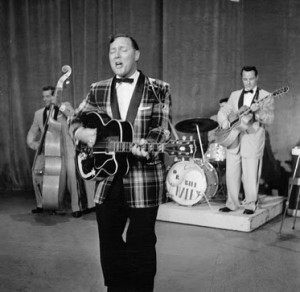At a minimum, most songs these days will use a verse-chorus or verse-refrain structure. Songs might be constructed of verses and nothing else, such as Amanda McBroom’s “The Rose”, made most famous by Bette Midler.
 Many old 12-bar blues songs are basically a verse and nothing else, though many will use a repeating refrain to end each verse, as we hear in Bill Haley & His Comets’ “Rock Around the Clock,” (written by Max C. Freedman and James E. Myers).
Many old 12-bar blues songs are basically a verse and nothing else, though many will use a repeating refrain to end each verse, as we hear in Bill Haley & His Comets’ “Rock Around the Clock,” (written by Max C. Freedman and James E. Myers).
These days, a typical song structure might include something more intricate, perhaps like the following:

Back in the early days of rock and roll, that kind of structure wouldn’t have been common, if only because typical hit songs you’d hear on the radio would be 2’00” to 2’30” in length — hardly enough time to accommodate all of the various sections you see in that plan.
But how do you know what your song needs? It may seem like these days, everyone’s writing a pre-chorus and a bridge. So how do you know if your song needs more than a verse and chorus format?
 The Pre-Chorus
The Pre-Chorus
A pre-chorus is a short section that gets inserted between a verse and a chorus. It might be seen as a second part of a verse, except that in songs that use pre-choruses, the verse sounds complete by itself; the pre-chorus usually acts as a new section.
A pre-chorus is generally used for any one or more of the following reasons:
- The verse melody is short, making it seem as though the chorus has arrived too soon.
- The verse chord progression is quite simple.. usually just 1 or 2 chords.
- The chorus and verse melodies are in very different ranges. If your verse is pitched very low, and your chorus melody much higher, a pre-chorus can help glue the two sections together.
- The chorus and verse melodies are in very similar ranges. Contrary to the previous point, if the verse and chorus melodies have little to distinguish each other, a pre-chorus can help draw a line between them.
- The verse lyric needs an emotional build to get to the chorus.
Of those points, the first one — the fact that the chorus seems to have arrived too soon, might be the most common one. Ideally, you should be at the chorus at the 45-second to 1-minute mark.
The Bridge
Whether or not a song needs a bridge has a lot to do with the lyric. A bridge gives you the opportunity to finish a lyric. Most of the time, bridge sections, which happen after the second chorus, will return for some final chorus repeats. Because of that, the bridge is the last chance you have to introduce new lyrics.
The bridge, as you likely know, usually has a completely different melody and accompanying chords. It takes the song in a new direction, and gives the audience something new to listen to.
But for your song, it may not be necessary to explore that new direction. Some songs really don’t need it, and in fact, a bridge might be an unnecessary complication to an otherwise simple song structure.
Here are three circumstances where you might consider a bridge to be a useful addition to your song:
- The lyric/story isn’t finished. If you need to expand on something described within your song’s lyric, a bridge might be the section that can do that.
- If the verse and chorus sound quite similar, a bridge — with its new melody, chords and lyric — can help add the necessary contrast.
- If you feel that your song in verse-chorus format is too short, a bridge can help to add to the length.
No matter what you decide to do regarding song form, remember that simplicity almost always surpasses complexity. Adding pre-choruses and bridges should only be done if it doesn’t overly complicate the structure and purpose of your songs.
 Written by Gary Ewer. Follow Gary on Twitter
Written by Gary Ewer. Follow Gary on Twitter
 Gary’s songwriting manuals are being used by thousands of songwriters to clean up their technique and write better songs. Get them at the Online Store.
Gary’s songwriting manuals are being used by thousands of songwriters to clean up their technique and write better songs. Get them at the Online Store.











A pre-chorus also can work right after Verse 1, but leading into Verse 2 instead of the first time through the chorus.
Thanks, Chris. I’ve been trying to think of a song that uses a pre-chorus to lead into verse 2, but can’t think of one. Do you know of one?
-G
Prog springs to mind. I’m pretty sure there are a number of Genesis songs for example that do the pre-chorus into a second verse. I’ve done it before. I like building the tension and then eventually when the chorus finally comes it’s like a great release. The other thing I tried out in my latest writing is finishing on a pre-chorus, which worked surprisingly well in one case!